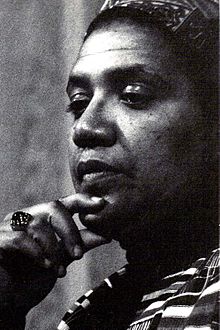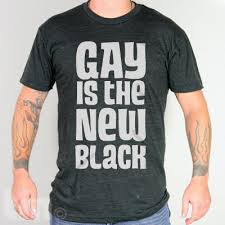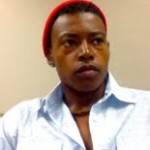Dispatch from the 'Very House of Difference': Anti-Black Racism and the Expansion of Sexual Citizenship – OR – We Need to Do So Much Better at Loving Each Other
By Kai M. Green and Treva Ellison
We (Treva and Kai) are Black, queer, trans, and anti-capitalist scholars, activists, and artists based in Los Angeles, where we dream about and plan for the abolition of racial capitalism and the growth of life-affirming relations and structures. We wrote this piece out of a desire to cultivate and build on conversations about how we can grow trust and solidarity across differences, build resilient and sustainable movements, while showing up as ourselves in the various communities that we inhabit.
Our place was the very house of difference rather than the security of any one difference.[1] – Audre Lorde, Zami
 We are sending this dispatch from what our Black unicorn ancestor Audre Lorde called, “the very house of difference.” This house is not a singular place, but it is a geography of injury and interdependence, one of pain and possibility. It is the corner of Market and Broad in Newark, where Sakia Gunn was murdered. It is the sidewalk in the West Village where the New Jersey 7 survived a homophobic attack. It’s at the corner of 27th Avenue and 29th Street outside the Schooner Tavern in Minneapolis where CeCe McDonald and her friends survived a racist and transphobic attack while walking home from the grocery store. We are live from the intersection, a place Alexis Pauline Gumbs describes as a “literal and psychic place of injury,” that requires transformation.
We are sending this dispatch from what our Black unicorn ancestor Audre Lorde called, “the very house of difference.” This house is not a singular place, but it is a geography of injury and interdependence, one of pain and possibility. It is the corner of Market and Broad in Newark, where Sakia Gunn was murdered. It is the sidewalk in the West Village where the New Jersey 7 survived a homophobic attack. It’s at the corner of 27th Avenue and 29th Street outside the Schooner Tavern in Minneapolis where CeCe McDonald and her friends survived a racist and transphobic attack while walking home from the grocery store. We are live from the intersection, a place Alexis Pauline Gumbs describes as a “literal and psychic place of injury,” that requires transformation.
To know the intersection is to struggle with and through the ensemble of forces that attempt to keep us in place and placeless at the same time. It means reckoning with inter-generational trauma, loss, and genocide. It means acknowledging the contradictions and multiple positions we inhabit and working through our privileges and differing relationships to “fatal couplings of power and difference.”[2] This is an uncomfortable place that is in constant flux and requires perpetual learning and unlearning. It is where we all need to dwell.
The recent string of rulings by the Supreme Court demand a moment of critical reflection and action about how we think, act, and strategize in the house of difference around the ways that the expansion of sexual citizenship is being articulated alongside the dismantling of policies and programs fought for and won by Black social movements. The overturning of the Defense Against Marriage Act (DOMA), dismissal of any solid legal standing for California’s Proposition 8, the defanging of the Voting Rights Act, along with the less talked about call for increased scrutiny of affirmative action programs, and the slight at the Indian Child Welfare Act (ICWA) must be read as a larger narrative of the normative exercise and iteration of hegemonic power. If we consider these decisions not as separate, but as a political statement, then we must ask, to borrow from Judith Butler, what regulatory discourses, frameworks of intelligibility and disciplinary regimes are reproduced by such statements?
We need to ask, what does the expansion of sexual citizenship, embodied in the DOMA / Prop 8 rulings, mean in the context of the attacks on and planned abandonment of programs and policies, like universal suffrage and public education, that were fought for and won by Black social movements alongside the expansion of death-dealing institutions and relations like debt, imprisonment, and homelessness. Anti-Black racism has historically been “the fulcrum of white supremacy,” meaning that anti-Black racism enables and underpins discourses, policies, and relations that idealize whiteness, harm a variety of people, and deepen spatialized patterns of suffering.
 One contradiction that conditions any attempt at reform in the current moment is between inclusive democracy and penal democracy. Desires and efforts to extend human and civil rights to include people of color, LGBT people, and other vulnerable groups are constrained by an increasing national investment in militarism and surveillance that depends on throwing countless others outside the realm and protection of human and civil rights. This representational trap plays out such that the production of legal subject-hood and citizenship for some is accompanied by the production of vulnerability for others.
One contradiction that conditions any attempt at reform in the current moment is between inclusive democracy and penal democracy. Desires and efforts to extend human and civil rights to include people of color, LGBT people, and other vulnerable groups are constrained by an increasing national investment in militarism and surveillance that depends on throwing countless others outside the realm and protection of human and civil rights. This representational trap plays out such that the production of legal subject-hood and citizenship for some is accompanied by the production of vulnerability for others.
Take for example the establishment of the 1994 Violent Crime Control and Law Enforcement Act which was lobbied for by numerous liberal and progressive organizations including the Human Rights Commission, the National Gay and Lesbian Task Force, the New York City Gay and Lesbian Anti-Violence Project, National Organization of Women, Fund for the Feminist Majority. Sections of the Act extended legal protections to women, while expanding national and local carceral geographies. The Act increased the life and scope of the prison industrial complex in several ways: it authorized funding for over 100,000 new police officers, $9.7 billion for prisons, it created 60 new death penalty crimes, made gang membership illegal, established a federal three-strikes policy, created federal penalties for repeat sex offenders, authorized the U.S Sentencing Committee to create enhancements for hate crimes, authorized the prosecution of minors being tried for violent crimes as adults, and ended federal Pell grants for prisoners seeking post-secondary education during their term of incarceration, to name a few things.
The Act also laid the foundation for the Matthew Shepard and James Byrd Jr. Hate Crimes Prevention Act, which was passed in 2009 as a part of the National Defense Authorization Act for Fiscal Year 2010. Both the military and prison industrial complexes exploit economic vulnerability, de-industrialization, and decades of disinvestment in and abandonment of poor communities, migrant communities, and communities of color. These systems of oppression expose people and places that capitalism has attempted to render obsolete to harm, violence, and premature death; they produce racism as a lived reality in place. It is notable that the one measure in the Violent Crime Control and Law Enforcement Act that was intended to address the disproportionate number of Black people on death row was dropped from the final version of the Act.
These moments of contradiction where at one moment we see a simultaneous gain and loss of civil rights are emblematic of our time, a coming out time, a moment when gay is the new Black, but somehow Black is still Black. We have to be better about our demands. Why ask to be incorporated into a system that continues to devalue some life in preference for others? Why ask to have the same protections under the law as Black people, when those protections have failed and are being revoked?
I recall recalling that moment in 2009 in my Feminist Theory Graduate seminar. I remember talking about the ways in which Black people became the scapegoats, the homophobic archaic folk who were the reason why prop 8 had been passed. I recall the moment when I was just about to say how wrong that portrayal was when I was cut off by my professor, a white cis-gender woman feminist, who seemed to think she knew exactly where I was going and chimed in, “Yea, because it wasn’t the Blacks, it was the Latinos.” I was baffled and I said, “No, that wasn’t where I was going with this at all.”
The notion that some people of color are the sole reason why Prop 8 passed in California was a trap. A trap to further sever the possible allegiances to be had between LGBT folk and Black folk. It does not only have to be those who live in the intersection who stand up for the intersections, though it often times happens this way. After the passing of Prop 8 there were numerous articles that went published saying that 70% Black Californians voted to pass Prop 8, this was indeed a misprint as the numbers were closer to 57%, not much different from other POC groups in Califonia. But more than that, the population of Black Californians was less than 10% meaning that if all Black voters had voted against the proposition it still wouldn’t have been enough to change the outcome.
Just as people saw the ascendancy of a Black President they also watched as a right was taken away. The racial tension that was felt was very real during the marches that occurred in West Hollywood after the passage of Prop 8. There were many who came to participate in the marches, like myself, who felt unwelcomed. This was a place for white anger, it was gay indeed, but it was also Anti-Black. Reports of racial slurs and threats of violence upon Black bodies were numerous. White LGBT groups felt they had given something to Black people, a Black president. With that gift, how could Blacks in turn betray the gays? How could the Blacks put the gays in the position of being the New Blacks?
Well, the answer is that President Obama was not a win for the Blacks, or the poor, or Africa, or Palestine, or Native Americans, or immigrants, or women, or the disappearing middle class. The unemployment rates for Black people is double the unemployment of white people. Though people of color only make up about 30% of the population, we make up 60% of those who are incarcerated. A Black president hasn’t made things better, period.
We must be careful not to fall into this representational trap because it will have us fighting to get our rights just as “Black people got theirs,” without having to consider the ways in which Black people have not yet reached that Promised Land. None of us have reached that Promised Land so we should stop focusing on becoming the new minority and figure out how to create the new majority that creates the new world based on what we need collectively.
 The productive tension between sexual citizenship and expansion of militarism, surveillance, policing, and incarceration rely on a discursive and material separation of race from sexuality. This is why for example, queer youth of color can be exposed to extreme police harassment and interpersonal harm even in so-called “gay ghettos.” The very question of whether “gay is the new black” requires and enacts a unconscionable forgetting of the systems of domination and creative destruction that operate in part through a construction of gay and Black as mutually exclusive. These kinds of representational traps attempt to make “equality” for queer racialized sexualities unintelligible and unthinkable as they support the kinds of relations that perpetuate harm and violence, sometimes against the very people they purport to protect.
The productive tension between sexual citizenship and expansion of militarism, surveillance, policing, and incarceration rely on a discursive and material separation of race from sexuality. This is why for example, queer youth of color can be exposed to extreme police harassment and interpersonal harm even in so-called “gay ghettos.” The very question of whether “gay is the new black” requires and enacts a unconscionable forgetting of the systems of domination and creative destruction that operate in part through a construction of gay and Black as mutually exclusive. These kinds of representational traps attempt to make “equality” for queer racialized sexualities unintelligible and unthinkable as they support the kinds of relations that perpetuate harm and violence, sometimes against the very people they purport to protect.
These harmful dichotomies aren’t just uni-directional in flow; they don’t just come from politicians and the HRC but also from us, from how we narrate and define our struggles. In the November 1978 November issue of “The Black Panther” journalist Reggie Major wrote a commentary titled “The Privileged ‘Oppressed,’ in which he criticizes White gay male gentrification in Alamo Square, Haight-Fillmore, and the Mission District. Majors notes that “some Blacks” take issue with the equation of the gay rights struggle with the Black liberation struggle saying: “One of the reasons for this objection is the fact that many gays are involved in exercising White male privilege at the very time they are claiming to be members of an oppressed group,”[3] Majors points out that White gay males have benefited from racist housing and loan policies by receiving bank loans, which were previously formally denied to Blacks, and taking advantage of the fact that Black-owned properties in Black neighborhoods were appraised at lower values. He makes a call for White gays to be in solidarity noting that Black organizations spoke out against the Briggs Initiative, which sought to bar gays and lesbians from working in California schools.
Majors ends the article with a call for solidarity: “There has to be a broad front that pushed for increased human and civil rights for all citizens, and Blacks and gays should be members of that front,”[4]. The disaggregation of race from gender and sexuality evinced in the separation of “gay” and “Black” helps to cohere the polemic and call to action but also participates in a framework of intelligibility that renders black queerness unthinkable and ignores how White gay gentrification impacts LGBT people of color and poor White LGBT people. When we frame our struggles in ways that ignore the various and complicated ways that harm and violence circulate, it becomes difficult for people to show up as themselves or in some cases to show up at all.
Desires for equality have a tendency to move people to become more invested in sameness instead of thinking about the reality of difference. We are not the same. Audre Lorde told us this. Toni Cade Bambara told us this. Gloria Anzaldúa told us this. Marlon Riggs told us this. We are not the same and it is our differences that give us strength. It is our ability to see that our freedoms are all connected and of equal value, but our oppressions while linked are not the same. We must not allow one kind of oppression to displace another in our political imaginaries, especially if that displacement is more of an ideological fallacy than a material reality.
For those who understand oppression through one dominant identity, say as a white woman, it might be easy to come together as women to rally around how this society devalues women’s lives and labor, but it might not be so easy to see the ways in which as a white women you can create systems that are oppressive and closed to women of color or people of color in general. We have to do better. Our lenses must be broadened so that at all times we are not only aware of our particular positions of oppression, but also our relative positions of privilege. Understanding privilege is not about guilt, though this is what seems to be happening these days. I don’t need you to feel bad about what happened during slavery or what’s happening with the expansion of the prison industrial complex. Guilt is paralyzing and it doesn’t produce much movement or change, it’s just stifling. Relinquish your guilt and use your privilege to change the structures that produce that privilege. Don’t include me in your privileged ranks, it means nothing if I can’t take my people with me. Barack Obama as first Black president means nothing if Black people as a class remain in crises.
This essay begins with recounting places and moments of injury. These stories are the kinds of stories that become unspeakable and unknowable in a discursive order and model of reform that privileges single-issue politics over mobilizing around the material conditions that produce trauma, vulnerability and death. There are certainly reforms to be made, but we need to become more aware of the places and people we are asked to give up in order to receive something that could easily be retracted. We don’t have to become Black. We don’t have to become gay. But we must be able to build beyond our own individual positions whether we stand in the intersection or not, we have to develop a model for recognizing the intersection, these moments when race, gender, class, citizenship, sexuality and ability collide (and they are always colliding). We must look for those who are lost; those who we’ve been asked to forget about because they are not our own. To dwell in the house of difference is to think, plan, and create with the intersection in mind and in heart.
The dispatch has been sent. Will you heed the call?



Pingback: » Dispatch from the ‘Very House of Difference’: Anti-Black Racism and the Expansion of Sexual Citizenship – OR – We Need to Do So Much Better at Loving Each Other Feminism 3.0: Praxis and Archives
Pingback: » Dispatch from the ‘Very House of Difference’: Anti-Black Racism and the Expansion of Sexual Citizenship – OR – We Need to Do So Much Better at Loving Each Other Feminism 3.0: Praxis and Archives
Pingback: » Dispatch from the ‘Very House of Difference’: Anti-Black Racism and the Expansion of Sexual Citizenship – OR – We Need to Do So Much Better at Loving Each Other Feminism 3.0: Praxis and Archives
Pingback: » Dispatch from the ‘Very House of Difference’: Anti-Black Racism and the Expansion of Sexual Citizenship – OR – We Need to Do So Much Better at Loving Each Other Feminism 3.0: Praxis and Archives